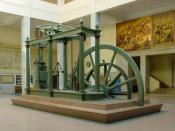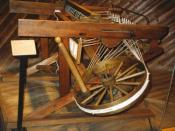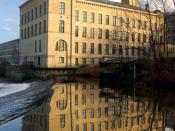The Industrial Revolution 1
The Industrial Revolution can be defined as the process of change from an agrarian economy to one dominated by industry and machine manufacture. This era, which took place from the 18th to the 19th centuries, not only marked a turning point in agriculture, society, transportation, and economic policies in England but also perceived a booming growing industry.
The replacement of traditional farming techniques for large-scale mechanized manufacturing resulted in migration of people from rural to urban areas. These modifications led to the creation of canals, roads and railways. Consequently, England drastically changed.
Causes
Industrial Change
The Industrial Revolution (see Appendix 1, picture 1) brought significant changes to the society of England and to the world (Schultz, 1968). In 1714 several products, such as clothes and buttons, were homemade. This process was done in cottages and involved all the members of the families living there. The process of buying and selling clothes in houses was referred to as cottage industry or, otherwise named, domestic system (see Appendix 1, picture 2) (Aylett, 1985).
Those goods firstly produced at home workshops were now made in factories by means of manpower instead of horsepower. Due to the increase in productivity, affluent factory owners became more prosperous, while factory workers suffered not only poverty, but also inequality (Schultz, 1968). Additionally, labourers worked in inhumane conditions (see Appendix 1, picture 3) (Lay, 1960).
"The workers suffered from ill- health and often from dreadful diseases, which were contracted from the dust of the cotton mills, the powdered steel from the grinding shops, or the lead form the earthenware factories; the change too, form the close heated factories to the cold air helped to bring on that frightful disease of consumption" (Lay, 1960, p. 101).
During the eighteenth century modern machinery was designed...


